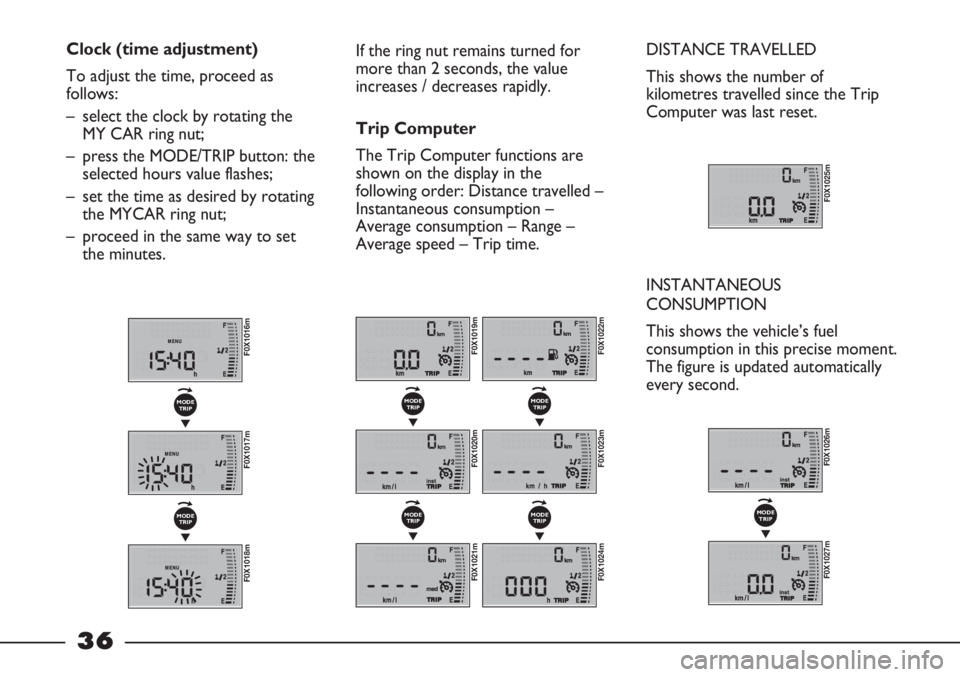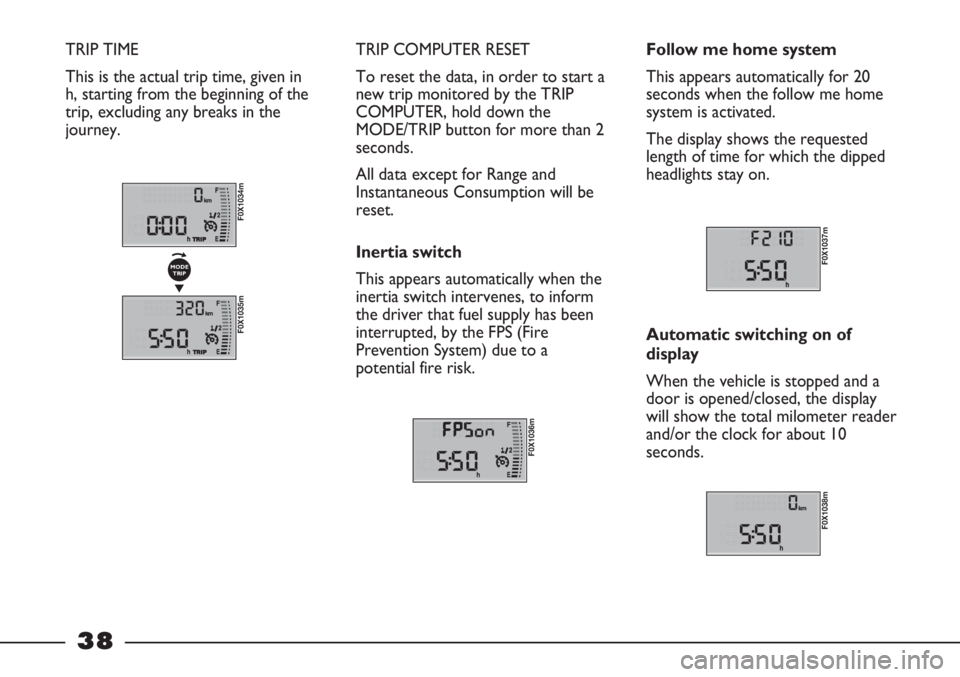2011 FIAT STRADA fuel consumption
[x] Cancel search: fuel consumptionPage 38 of 195

36
Clock (time adjustment)
To adjust the time, proceed as
follows:
– select the clock by rotating the
MY CAR ring nut;
– press the MODE/TRIP button: the
selected hours value flashes;
– set the time as desired by rotating
the MYCAR ring nut;
– proceed in the same way to set
the minutes.If the ring nut remains turned for
more than 2 seconds, the value
increases / decreases rapidly.
Trip Computer
The Trip Computer functions are
shown on the display in the
following order: Distance travelled –
Instantaneous consumption –
Average consumption – Range –
Average speed – Trip time.DISTANCE TRAVELLED
This shows the number of
kilometres travelled since the Trip
Computer was last reset.
INSTANTANEOUS
CONSUMPTION
This shows the vehicle’s fuel
consumption in this precise moment.
The figure is updated automatically
every second.
F0X1025m
F0X1019m
F0X1020m
▼
MODE
TRIP
F0X1021m
▼
MODE
TRIP
F0X1022m
F0X1023m
▼
MODE
TRIP
F0X1024m
▼
MODE
TRIP
F0X1016m
F0X1017m
▼
MODE
TRIP
F0X1018m
▼
MODE
TRIP
F0X1026m
F0X1027m
▼
MODE
TRIP
Page 39 of 195

37
AVERAGE CONSUMPTION
This is the relationship between the
distance travelled and the number of
litres of fuel used, since the
beginning of the journey. The figure
is updated automatically every 10
seconds.
The calculation starts after having
driven at least 500 metres from the
beginning of the journey.RANGE
This is an estimate of the maximum
distance in kilometres, that can be
driven with the volume of fuel
currently present in the tank
(assuming that the driving style
adopted up to this point continues).
The calculation is based on the
average consumption in the last 5
minutes. If the car is refuelled,
another range value will be
calculated automatically.
With the vehicle stationary and
engine running or when driving at
less than 4 km/h, the display will
show the previous range value; if this
vehicle condition persists for more
than 3 minutes, this will change and
the following will be displayed: - - - -.
F0X1028m
F0X1029m
▼
MODE
TRIP
F0X1030m
F0X1031m
▼
MODE
TRIP
AVERAGE SPEED
This is an estimate of the average
speed, calculated from the beginning
of the journey.
F0X1032m
F0X1033m
MODE
TRIP
▼
Page 40 of 195

38
TRIP TIME
This is the actual trip time, given in
h, starting from the beginning of the
trip, excluding any breaks in the
journey. TRIP COMPUTER RESET
To reset the data, in order to start a
new trip monitored by the TRIP
COMPUTER, hold down the
MODE/TRIP button for more than 2
seconds.
All data except for Range and
Instantaneous Consumption will be
reset.
Inertia switch
This appears automatically when the
inertia switch intervenes, to inform
the driver that fuel supply has been
interrupted, by the FPS (Fire
Prevention System) due to a
potential fire risk.
F0X1036m
Follow me home system
This appears automatically for 20
seconds when the follow me home
system is activated.
The display shows the requested
length of time for which the dipped
headlights stay on.
F0X1037m
Automatic switching on of
display
When the vehicle is stopped and a
door is opened/closed, the display
will show the total milometer reader
and/or the clock for about 10
seconds.
F0X1038m
F0X1034m
F0X1035m
▼
MODE
TRIP
Page 50 of 195

48
Cons. (fuel consumption unit)
This function, present only on some
versions/markets where provided,
allows the unit of measurement used
to calculate fuel consumption to be
selected: km/l or l/100km.
Proceed as follows:
– press the MODE button briefly:
km/l or l/100km (depending on
the previous setting) flashes on
the display;
– press the ▼or ▲button to
select;
– press the MODE button briefly to
confirm;
– hold down the MODE button to
return to the standard display. Door Lock
(with vehicle in motion)
This function, present only on some
versions/markets where provided,
allows automatic locking of doors
above a speed of 20 km/h to be
activated.
To activate (ON) or deactivate
(OFF) the function, proceed as
follows:
– press the MODE button briefly:
ON or OFF (depending on the
previous setting) flashes on the
display;
– press the ▼or ▲button to
select;
– press the MODE button briefly to
confirm;
– hold down the MODE button to
return to the standard display.Dist. Unit (distance unit)
This function, present only on some
versions/markets where provided,
allows the unit of measurement used
to calculate distance to be selected:
km or mi.
Proceed as follows:
– press the MODE button briefly:
km or mi (depending on the
previous setting) flashes on the
display;
– press the ▼or ▲button to
select;
– press the MODE button briefly to
confirm;
– hold down the MODE button to
return to the standard display.
Page 55 of 195

53
Values displayed
Range
This value shows the distance that
the car can still cover before needing
fuel, assuming that driving style is
unvaried. The display will show the
reading “----” when the following
events take place:
– range value lower than 50 km
(or 30 mi)
– vehicle stopped with engine
running for an extended period.
Distance travelled
This value shows the distance
covered from the start of the new
mission.
Average consumption
This value shows the average
consumption from the start of the
new mission.
Instantaneous consumption
This value shows the fuel
consumption. The value is constantly
updated. “----” will appear on the
display if the vehicle is stopped with
the engine running.Average speed
This value shows the average speed
of the vehicle considering the overall
time elapsed since the start of a new
journey.
Trip time
This value shows the time elapsed
since the start of the new mission.
IMPORTANT In the absence of
information, all Trip Computer
values are displayed with “----”
instead of the value. The various
values will be counted as normal
when standard operating conditions
are restored. This will not reset any
of the values displayed before the
failure nor will it start a new trip.TRIP button fig. 53
The TRIP button is located at the
end of the right stalk. With the
ignition key turned to MAR-ON, it
allows the parameters described
previously to be viewed, as well as
reset for a new trip:
– brief press to access the various
parameter displays
– long press to reset and thus start
a new mission.
fig. 53
F0X0154m
Page 62 of 195

Contact a Fiat
Dealership as soon as
possible if the
U
warning light does not switch on
when the ignition key is turned
to MAR or if it switches on
when driving (together with a
message on the display on some
versions). The operation of the
Uwarning light may be
checked by the traffic control
authorities using specific
devices. Always comply with the
traffic regulations in force in the
country where you are driving.
INJECTION SYSTEM
FAILURE (amber)
In normal conditions, when the
ignition key is turned to MAR, the
warning light switches on, but should
switch off when the engine starts.
If the warning light stays on or
comes on when travelling, it means
there is a fault in the injection
system which could cause loss of
performance, poor handling and high
fuel consumption levels.
On some versions, the display shows
a dedicated message.
Under these conditions, the vehicle
can continue travelling at moderate
speed without demanding excessive
effort from the engine. In any case,
you should contact a Fiat Dealership
as soon as possible. DOORS NOT
CLOSED
CORRECTLY (red)
On certain versions, the warning
light switches on when one or more
doors are not closed correctly. On
some versions, the display shows a
dedicated message. On some
versions, an acoustic signal is emitted
when the vehicle is in motion.SEAT BELTS NOT
FASTENED (red)
(for versions/markets,
where provided)
The warning light on the panel
switches on constantly when the
vehicle is stationary and the driver
side seat belt is not fastened correctly.
It will flash, and be accompanied by a
buzzer, if the front seat belts are not
fastened correctly when the vehicle is
in motion.
<
´
U
60
Page 114 of 195

112
FUEL SAVING
Here are some useful tips to save
fuel and minimise harmful emissions
of CO
2and other pollutants (nitric
oxides, unburnt hydrocarbons,
particulate matter etc.).
GENERAL CONSIDERATIONS
The general factors that affect fuel
consumption are listed below.
Vehicle maintenance
Have checks and adjustments carried
out on the vehicle in accordance
with the “Scheduled Servicing Plan”.Tyres
Check the pressure of the tyres
routinely at an interval of no more
than 4 weeks: if the pressure is too
low, consumption levels increase as
resistance to rolling is higher.
Unnecessary loads
Do not travel with excess load.
The weight of the vehicle (especially
when driving in town), and its trim
greatly affect consumption and
stability.
Roof rack/ski rack
Remove the roof rack or the ski
rack from the roof after use.
These accessories reduce the
vehicle’s aerodynamic penetration
and have a negative effect on
consumption. When transporting
particularly large objects, use a
trailer if possible.Electrical devices
Use electrical devices only for the
amount of time necessary. The
additional headlights, windscreen
wipers and heater fan consume a
considerable amount of energy,
thereby increasing fuel consumption
(by up to 25% in the urban cycle).
Climate control
Climate control leads to higher fuel
consumption (on average by up to
20%): if the temperature outside
permits, try and use the ventilation
only.
Devices for aerodynamic
control
The use of non-certified devices for
aerodynamic control may adversely
affect air drag and consumption
levels.
DRIVING STYLE
The main driving styles that affect
fuel consumption are listed below.
Page 115 of 195

113
Starting
Do not warm up the engine at low
or high revs when the vehicle is
stationary; this causes the engine to
warm up more slowly, thereby
increasing fuel consumption and
emissions. It is advisable to move off
immediately and slowly, avoiding
high speeds: in this way the engine
will warm up more quickly.
Unnecessary actions
Avoid accelerating when stopped at
traffic lights or before stopping the
engine.
This, as well as double declutching, is
absolutely unnecessary and increases
consumption and pollution.
Gear selection
As soon as the conditions of the
traffic and road permit, use a higher
gear.
Using a low gear for faster
acceleration will increase
consumption.Improper use of a high gear
increases consumption, emissions
and engine wear.
Maximum speed
Fuel consumption increases
considerably with speed. Maintain a
constant speed, avoiding
unnecessary braking and
acceleration, which cost in terms of
both fuel and emissions.
Acceleration
Accelerating violently will greatly
affect consumption and emissions:
acceleration should be gradual.
CONDITIONS OF USE
The main usage conditions that
negatively affect fuel consumption
are listed below.Cold starting
Short journeys and frequent cold
starts do not allow the engine to
reach optimum operating
temperature.
This results in a significant increase
in consumption levels (by 15–30% in
the urban cycle) and emissions.
Traffic and road conditions
Rather high consumption levels are
linked to situations with heavy
traffic, for instance when travelling in
queues with frequent use of the
lower gears or in cities with many
traffic lights. Winding mountain
roads and rough road surfaces also
adversely affect consumption.
Stopping in traffic
During prolonged hold-ups
(e.g. at level crossings) the engine
should be switched off.